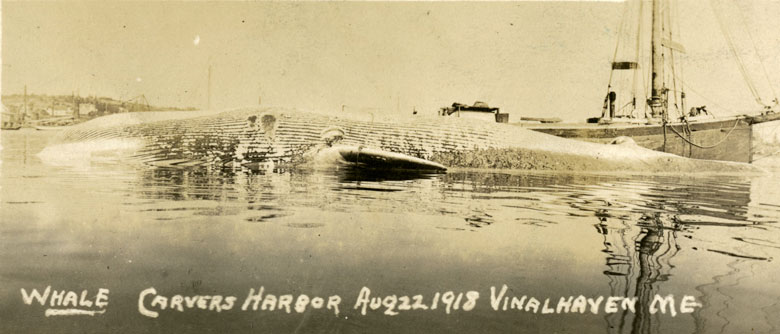Menhaden, also referred to as pogies or mossbunkers, are currently one of several species of bait fish used in the lobster industry. Historically, these fish were harvested for entirely different purposes: leather production and agriculture.
By the mid-19th century, numerous oil processing plants were established in Maine to refine menhaden into fish oil for leather tanning, with the remnant fishmeal serving as a practical substitute for imported fertilizers such as Peruvian guano (seabird waste).
The success of these plants created a demand that could not be met when menhaden ceased to migrate north of Cape Cod in 1879. Consequently, fishermen turned to marine mammal species to compensate for the shortfall, leading to unprecedented whaling activity in Maine waters.
Advancements in whaling technology, such as bomb lances fired from steam-powered vessels, revolutionized the process…
Due to the significant amount of oil that could be extracted from them, whales were considered a viable alternative. Humpback and fin whales were particularly targeted due to their local availability.
However, capturing a whale was a challenging endeavor. Advancements in whaling technology, such as bomb lances fired from steam-powered vessels, revolutionized the process compared to earlier methods involving hand-thrown harpoons from rowboats.
As menhaden fishermen already employed steamers, they began harvesting whales and towing them to processing facilities. At the peak of the fishery, annual catches often exceeded 100 whales, typically divided between the two species.
With the eventual return of menhaden in 1886, whaling activities dwindled. Maine’s coastal whale fishery served as a temporary substitute during the absence of menhaden but proved economically unsustainable. This was largely due to inadequate investment in efficient whaling equipment, with fishermen making do with makeshift adaptations while awaiting the menhaden’s return.
Some industrious menhaden whalemen had an extra line of income by charging spectators a fee to view the floating carcasses. The novelty was certainly absent for those adjacent to the oil plants. Local communities often opposed the processing aspect of the industry due to the overwhelming stench it produced.
Among the menhaden whalemen was Capt. William G. Butman, who landed whales from the steamer Hurricane in the 1880s and resumed the practice 30 years later aboard the 51-foot Palm.
The photograph accompanying the column, dated Aug. 22, 1918, depicts a whaling station at Carver’s Harbor in Vinalhaven that was established by Butman and others. Though details about its operation and longevity are scarce, it stands as a notable exception in the history of whaling in the region.
Capt. Butman was better known as the owner and operator of passenger steamers serving Matinicus and Criehaven. The Palm is also cited as serving this purpose. This image serves as a rare example documenting the fishery and was received by Maine Maritime Museum directly from the Butman family.
Kelly Page is curator of collections at Maine Maritime Museum. The museum’s newest exhibits include Upta Camp, and Lost & Found: Sounds of the Maine Coast by Dianne Ballon. Explore resources and plan your visit at www.mainemaritimemuseum.org





